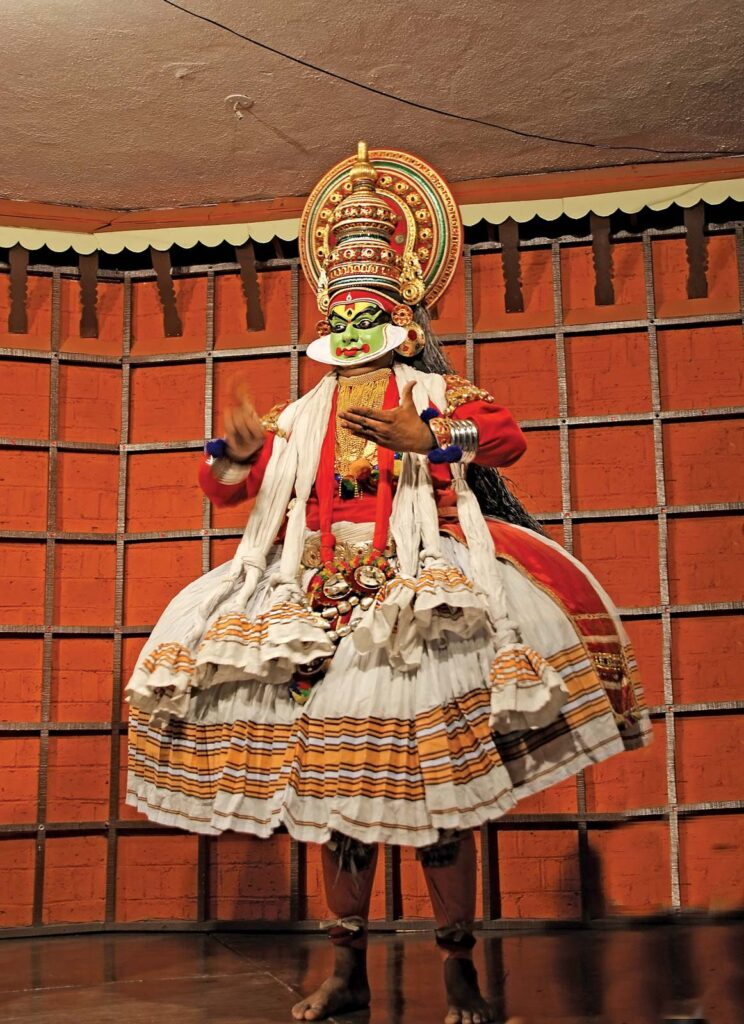Folk Dances of India: Kathakali
Kathakali is a major classical dance form from Ancient India. It is a “story play” of art that includes elaborate, colourful makeup, beautiful mesmerizing costumes and face masks traditionally performed by male dancers. It is a Hindu folk dance performed in the Malayalam speaking southwest region of Kerala. Kathakali is derived from Katha, which means “story or a traditional tale”, and Kalī means “performance or art”.1 Kathakali is a long tradition that symbolizes the eternal fight between good and evil. It was given its present form by Mahakavi Vallathol Narayan Menon, the founder of the Kerala KalaMandalam.
Being a more relatable form of art strikes a chord with the public as it embodies their customs and religions. It involves vigorous and florid movements, stylized gestures and loads of facial expressions. These gestures are broad and robust, and faces are made from face paint which look like masks. The characters of Kathakali express their emotions and the story through songs from the background and their unique loud expressions. Dances rely on hand gestures, known as mudra, to convey the soul of the story.2,3 Costumes, makeup and face masks are the most distinguishing features of this classical dance. There are several kinds of costumes including, Sathwika (the hero), Kathi (the villain), Minukku (females), and Thatti.1 Each character is easily recognizable by his makeup, costume and mask. This costume consists of a full skirt and heavy jacket with embellished garlands and jewellery.4 The musical notes of Kathakali are similar to the traditional classical music of South India; however, the instruments used are different. Chenda, idakka, and shuddha madalam are the most common instruments used.3 It leaves a spellbound experience to its viewers and performs epic Indian ancient folklore with the most intricate and mesmerizing movements.
Kathakali combines drama, dance, music, storytelling, costumes, makeup and devotion into a divided experience. It brings humanity into Hinduism and expresses emotions beyond words.2 These temple rituals have evolved into a vibrant drama that encircles the essence of being a human. It provides a spectacle to live and an opportunity to view the ancient lifestyle and heritage preserved for centuries.5 This theatre has now reached the doors of the most powerful forms of storytelling in the world theatre and unlocked appreciation for Indians worldwide. Kathakali unlocked the mystery of the Sanskrit poems and made them accessible to the broader community.
___________________
Independent Project by Sezal Chug
Guide: Prof Manohar Khushalani
__________________
-
1.encyclopedia wikipedia. Kathakali. Wikipedia, the free encyclopedia. https://en.wikipedia.org/wiki/Kathakali#:~:text=Kathakali%20(Malayalam%3A%20%E0%B4%95%E0%B4%A5%E0%B4%95%E0%B4%B3%E0%B4%BF)%20is,traditionally%20male%20actor%2Ddancers%20wear.
-
2.Tourism K. kathakali. keralatourism. https://www.keralatourism.org/artforms/kathakali-kerala-theatre/15
-
3.britannica britannica. kathakali. britannica. https://www.britannica.com/art/kathakali
-
4.Indian Folk dance chandrakantha. Kathakali. chandrakantha. https://chandrakantha.com/articles/indian_music/nritya/kathakali.html
-
5.background kathakali. kathakali. kathakali.net. https://www.kathakali.net/background


